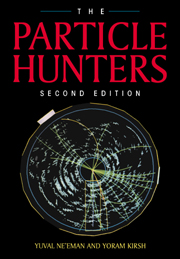Book contents
- Frontmatter
- Contents
- Preface to the first edition
- Preface to the second edition
- 1 The building blocks of the atom
- 2 Physical laws for small particles
- 3 The discoveries of the 1930s and 1940s
- 4 Particle accelerators — or from hunters to farmers
- 5 Strange particles
- 6 Basic forces and the classification of particles
- 7 Conservation laws
- 8 Short-lived particles
- 9 To the quarks — via the eightfold way
- 10 More quarks — or charm, truth and beauty
- 11 The Standard Model and beyond
- Appendix 1 Properties of semi-stable particles
- Appendix 2 The Greek alphabet
- Name index
- Subject index
4 - Particle accelerators — or from hunters to farmers
Published online by Cambridge University Press: 05 August 2012
- Frontmatter
- Contents
- Preface to the first edition
- Preface to the second edition
- 1 The building blocks of the atom
- 2 Physical laws for small particles
- 3 The discoveries of the 1930s and 1940s
- 4 Particle accelerators — or from hunters to farmers
- 5 Strange particles
- 6 Basic forces and the classification of particles
- 7 Conservation laws
- 8 Short-lived particles
- 9 To the quarks — via the eightfold way
- 10 More quarks — or charm, truth and beauty
- 11 The Standard Model and beyond
- Appendix 1 Properties of semi-stable particles
- Appendix 2 The Greek alphabet
- Name index
- Subject index
Summary
The first accelerators
In the 1930s and 1940s, cosmic rays were the only source of new particles. The high-energy cosmic particles are excellent projectiles for splitting nucleons and producing new elementary particles, and physicists indeed made good use of them for this purpose. However, the disadvantage of this source of radiation is that it cannot be controlled. All that can be done is to send instruments or photographic films into the upper atmosphere and wait for results. If one wishes to investigate a certain process, occurring at a particular energy, one has to sort through a very large number of photographs in order to find a few containing the required information, if at all. As the research of the particle world strode forwards, physicists wanted to imitate in the laboratory the processes produced by the primary cosmic particles. For this purpose they had to accelerate charged particles — protons and electrons — to high speeds with the aid of electric and magnetic fields. This transition ‘from hunters to farmers’ took place in the 1940s, although its beginnings were in the early 1930s.
The first machine for accelerating particles was built over the years 1928 to 1932 in Rutherford's laboratory (the Cavendish Laboratory) at Cambridge.
- Type
- Chapter
- Information
- The Particle Hunters , pp. 89 - 109Publisher: Cambridge University PressPrint publication year: 1996



